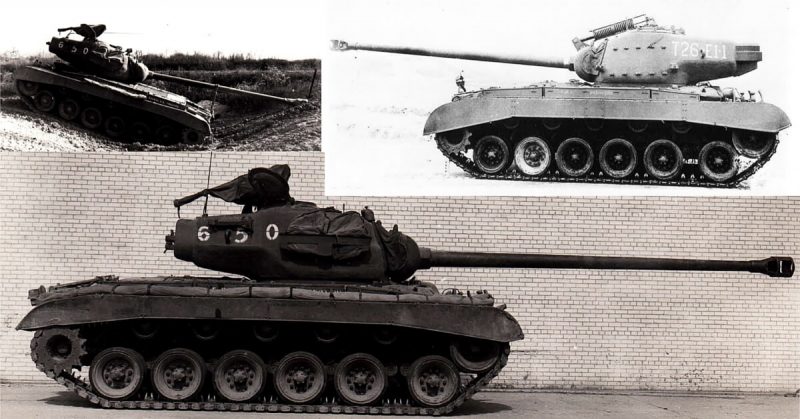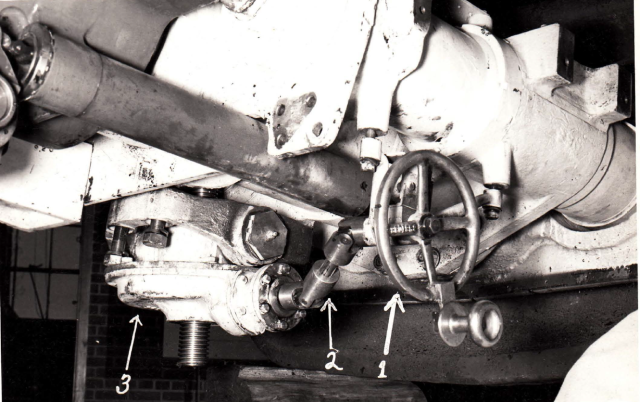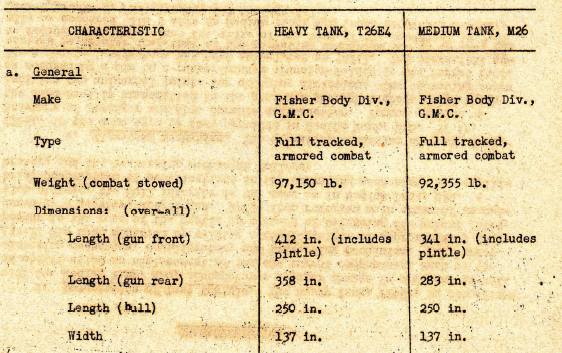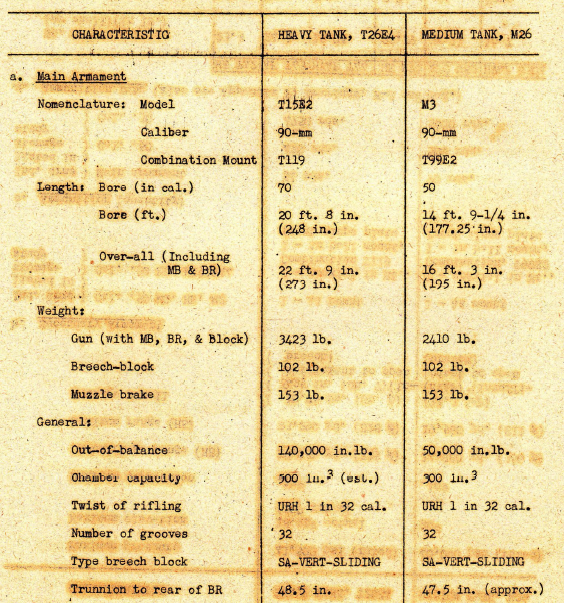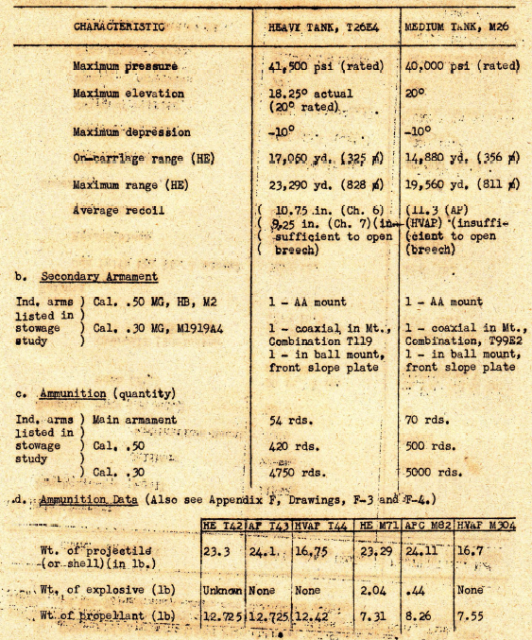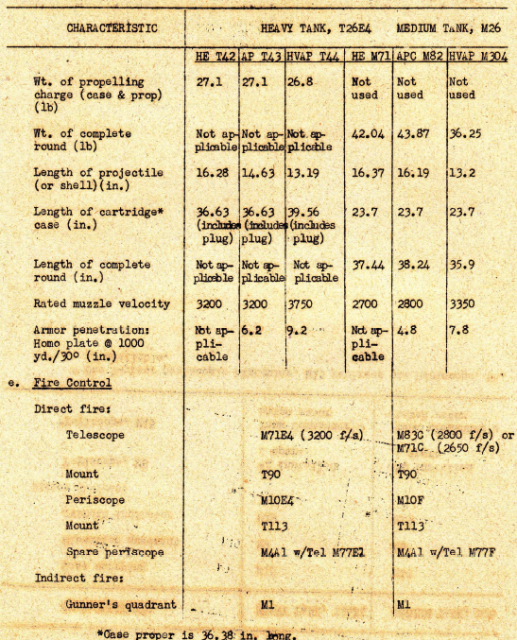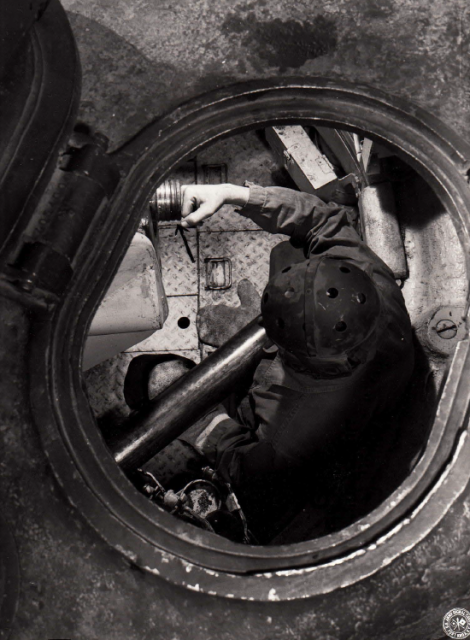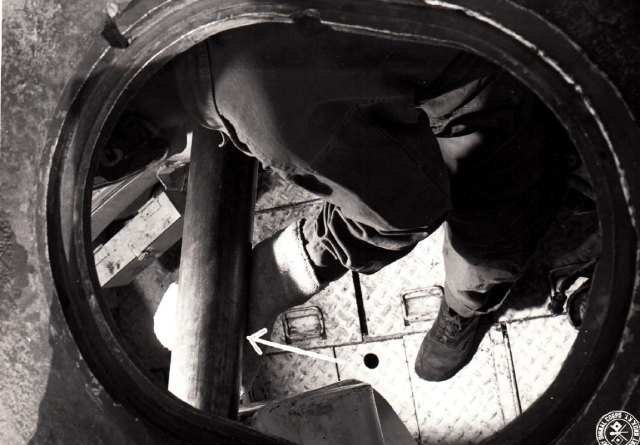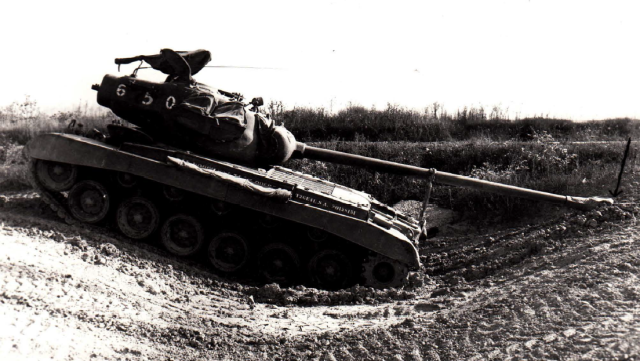The exploits of the T26E4 in Europe are well known. Indeed, there is much anticipation for the release of the HD model of the tank in the upcoming update. It is, of course, known that the Super Pershing we all know and love was not an entire success, not least because the ammunition its T15E1 rifle used was single-piece and incredibly unwieldy. It is also known (albeit slightly less so) that an improved version of the T15E1 was developed, the creatively named T15E2, and that was designed to use split-piece ammunition, supposedly to fix this problem. Yet when M26’s replacement was developed, M46, it still retained the shorter 90mm M3-based gun. What happened?
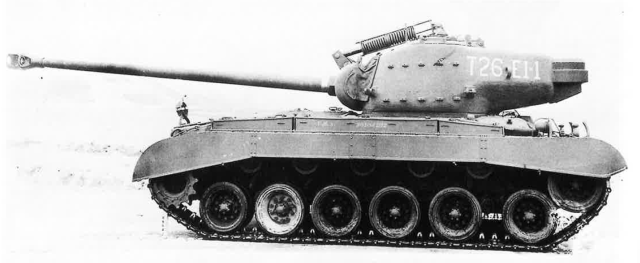
Believe it or not, it wasn’t until mid to late 1946 that Armored Board actually got a hold of one of the vehicles to test for itself. The report was published in April 1947, and the answer to the above question can be found within.
First, the background.
The 90mm Gun, T15E2 development was initiated during the war as a possible solution to the ever-increasing demand for higher velocity guns on U. S. Army tanks. Originally designated as 90mm Gun, T15, it was chambered for complete round ammunition and was installed in a Medium (then-Heavy) Tank, T26E1, for proof firing at Aberdeen Proving Ground, Maryland. Trials at Aberdeen indicated that it was feasible to mount such a gun in a tank of the T26 class. It was apparent, however, that a fixed round of the proportions required for ‘this weapon (over-all length of approximately 50 inches) could not be handled in the limited space of a tank turret, and the decision was made to redesign the gun for separated projectile and propelling charge. The redesigned gun was designated 90mm Gun, T15E2. In February 1945, the decision was made to divert 1000 units of Heavy Tank, T26E3, to the production of the same number of Heavy Tanks, T26E4,mounting 90mm Gun, T15E2. Cessation of hostilities in the Pacific area brought about drastic reductions in procurement schedules. Accordingly, Heavy Tank, T26E4 procurement was cut back from 1000 units to 25 units, and reclassification of’ the vehicle from limited procurement type to service test type was effected.
So, the description of the test vehicle.
The Heavy Tank, T26E4, in comparison with the Medium Tank, M26, incorporates a major change in armament as well as modification or replacement of various turret components, such as the elevating mechanism, equilibrator, and traversing mechanism. The turret itself has been modified by welding a counterweight of approximately 2,500 pounds to the rear of the bustle as a means of balancing the moment introduced by a heavier, longer gun. Aside from reworked main armament ammunition stowage, the hull interior is the same as in Medium Tank, M26. A brief description of modifications in the elevatingmechanism, the equilibrator, and the traversing mechanism follows:
a. Elevating mechanism. The elevating mechanism of Heavy Tank, T26E4, is the same type as approved in Medium Tank, M26. It is, however, of stronger and more durable construction.Torque applied at the handwheel is transmitted to the gear box through a cross-shaft which contains two universal joints for changing direction. The mechanical advantage has been calculated as 542:1. The mechanical advantage is greater than that of the elevating mechanism for 90mm Gun, M3, in Medium Tank M26, since the valve of one turn of the handwheel is 3.25mils as compared with 5 mils in Medium Tank M26.
b. Equilibrator. The 90mm Gun, T15E2, is rated as 140,000 inch-pounds out of balance (muzzle heavy) and the coil spring equilibrator for 90mm Gun, M3, in Medium Tank, M26 is deemed incapable of dealing with this condition. The equilibratorinstalled in Heavy Tank, T26E4, is a hydro-pneumatic type, utilizing oil, recoil special, and nitrogen. The relationship betweenease of elevation and ease of depression may be regulated by pumping additional oil into the bottom of the pressure tank (easier elevation) or by opening a valve and permitting a limited quantity of oil to flow back into the reservoir (easierdepression). Theoretically, a perfect adjustment results in equal effort for both elevating and depressing the gun.
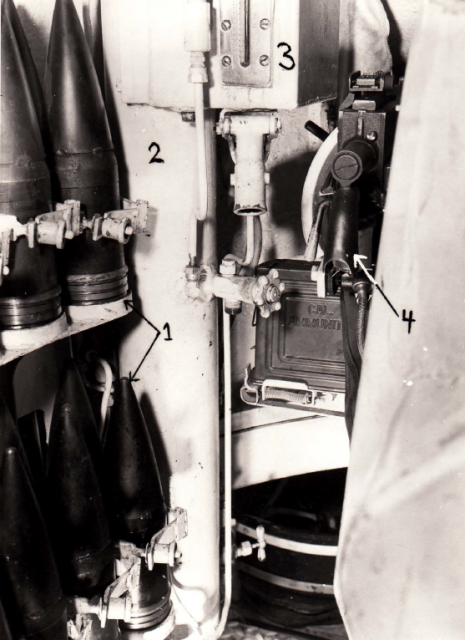
Traversing mechanism:
Manual: The manual traversing mechanisms in the Heavy Tank T26E4 and the Medium Tank M26 are identical.
Power: In order to deal with substantially increased turret weight, an increase in gear reduction amounting to about 20 percent has apparently been provided in the power traversing mechanism of Heavy Tank T26E4. This statement is based on findings that the “Open” rate of traverse is approximately 3.3rpm in Medium Tank M26 and only 2.6rpm in Heavy Tank T26E4.
The test report then does a nice side-by-side comparison, before delving into the tests.
And let the test copy/pasting begin.
1. PRE-OPERATION MAINTENANCE.
a. Equilibrator: Service of the hydro-pneumatic equilibrator requires special equipment not normally carried below battalion maintenance levels. Instructions for servicing must be carefully followed for good results as well as for the sake of safety. Use of this equipment introduces an additional training problem.
b. Exterior Travel Lock. Unless the exterior travel lock and the turret ring lock can be engaged simultaneously, the swinging moment of the turret during cross country operation will result in a severe loading of the gun trunnions (exterior lock only,) orthe turret ring lock (ring lock only).
2. ELEVATION SYSTEM FRICTION. Favorable results obtained by Aberdeen Proving Ground with needle type trunnion bearings and modified equilibrator piston sealing (90mm Gun, T15E2 mounted in Heavy Tank, T32) show conclusively that the installation tested by Army Ground. Forces Board No. 2 is inferior in so far as friction is concerned. There still appears to be some doubt, however, as to whether the needle type bearings will withstand the shock of firing and of cross-country movement as well as the bushing type.
3. ELEVATING HANDWHEEL EFFORT. Elevating handwheel effort in Heavy Tank, T26E4 is so high as to be prohibitive. Any increase in gear reduction to reduce this effort will further aggravate the already critical handwheel response (3.26mil per turn).
4. TURRET TORQUE. Turret Torque on Heavy Tank, T26E4 is significantly higher than that on Medium Tank, M26 and there is indication of substantial turret out of balance.
5. OPERATION OF MANUAL TRAVERSING MECHANISM. Traversing handwheel effort is generally satisfactory; however, when the turret is canted or pitched the out of balance feature of the turret causes variations rising to an undesirable high of’ about 15 pounds effort at one point when the turret is pitched or canted as much as 17°
6. POWER TRAVERSE RESPONSE. The overall response of the power traverse mechanism in Heavy Tank, T26E4, is not as desirable as that provided by the installation of a special control cam in the Oilgear system of Medium Tank, M26. The latter provides a very slow increase of traversing rate in proportion to the inclination of the control handle; however, the response in Heavy Tank, T26E4 is sufficiently fine at low power traverse control handle inclinations to permit laying on point targets.
7. ELECTRICAL LOAD (Power Traverse). Current draw on the vehicular electrical system can be expected to rise with theadvent of heavier turrets. The demand becomes more acute when dealing with both increased weight’ and increased turret out of balance, as in the Heavy Tank, T26E4.
8. AVAILABILITY OF AMMUNITION. Ammunition consisting of separating projectiles and propelling charges is not conducive to accomplishing high rates of fire. In Heavy Tank T26E4, the loader must contend with a stowage arrangement in which he must remove each propelling charge from a floor bin or sponson rack. Non-uniformity of bin size makes stowage of Charge, Propelling, T7 impossible except in designated bins. There are numerous parts of the turret interior which interfere with removal of charges and projectiles.
9. STOWAGE. Stowage of Heavy Tank T26 is unsatisfactory with regard to arrangement of main armament ammunition propelling charges and positioning of the vehicular SCR-508 radio. No ready propelling charges are provided and the radio stowed in a long axis position is altogether inaccessible to the loader and is very difficult for the tank commander to operate.
10. JUMP FIRING. Jump firing of 90mm gun T15E2 on Heavy Tank T26E4 indicates a consistent left horizontal jump and consistent down jump at all turret positions tested. The magnitude of the jump decreases when firing at 45° traverse and shows a further decrease when firing at 90° traverse. The over-all difference of almost 1mil in horizontal jump between 0° traverse and 90° traverse is significant. Present methods of determining jump are subject to some question, but the theory that jump varies in both magnitude and/or direction from gun to gun remains unchanged.
11. DISPERSION FIRING. Dispersion produced by armor piercing types of ammunition fired from 90mm Gun T15E2 is slightly less in deflection and slightly more in elevation than the acceptable standard for all tank guns. It is possible that increase in elevation dispersion may be due to defective ammunition.
12: EVALUATION OF OBSCURATION AND TRACER. Obscuration produced by the firing of the various types of ammunition for 90mm Gun T15E2 is significantly greater than that produced by improved ammunition (long primers and nitroguanadine propellant) now provided for 90mm Gun M3. The tracer element of HVAP-T44 is considered to be satisfactory; that of AP T43 is considered to be unsatisfactory. Packaging of AP T43 was found to be inferior.
13. TEST OF CENTER OF IMPACT FIRING. Excessive dispersion of the long range center of impact gives emphasis to the generally known fact that a relatively light shell will produce a large dispersion pattern at long ranges. Firing table probable error for 90mm Gun T15E2 has not been published; however comparison of the results which were obtained with probable error figures for 90mm Gun, M3 (Firing Shell, HE, M71) shows (theoretically) a very distinct difference in favour of the 90mm Gun, M3. Again, the difference could well have been due to faulty ammunition.
14. DAMAGE TO MUZZLE BRAKE AND TUBE. Damage to the muzzle brake and tube of 90mm Gun T15E2, is believed to be wholly attributable to incorrectly designed ammunition. It appears that damage to the muzzle brake occurs most frequently during use of armor piercing types of ammunition.
15. CROSS COUNTRY OPERATION
a. Breakages and adjustments. Breakages of various components of the traversing mechanism indicate the requirement for redesign to provide durability and strength.
b. Effect of gun tube length. The design of tank cannon must take into consideration the restrictions on vehicular maneuverability imposed by specially long tubes. It is probably that, unless basic design is changed, the length of development guns suitable for tank use will be of considerable proportion. This throws a new light on the importance of power elevation which must be of necessity be provided in order that the gunner may, in effect, elevate and depress his gun to conform to vehicular maneuver as he now does with power traverse.
16. OPERATIONAL AND MAINTENANCE DATA. Operational data based on less than 500 miles of test operation compare favorably with similar data recorded in the fleet test of Heavy Tank T26E3, except with respect to engine oil consumption. The maintenance requirements of Heavy Tank T26E4 during this period amounted to almost half as many man hours as did the average for seven vehicles in the fleet test on which average was better than four times as much.
Overall, a study of the test results and comparative data indicated that the installation of 90mm Gun T15E2 in Heavy Tank T26E4 was not entirely successful since the engineering problems posed by the installation of a longer, heavier weapon in a turret not specifically designed for the purpose were not solved in this vehicle. Excessive time and effort were required to elevate and depress the main armament, and a high mortality rate on traversing mechanism parts resulted during the limited cross-country operation performed. Some reduction in maneuverability and mobility of the Heavy Tank T26E4, attributable to the longer, heavier gun was observed. Stowage arrangement of the main armament ammunition was found to be unsatisfactory. Service of the piece incident to firing tests indicated conclusively that use of the separated projectile and propelling charge required with the test installation had an adverse effect on crew efficiency, which is largely the cause of the reduced rate of fire. The rate of fire of the 90mm Gun, T15E2, was substantially less than that possible with the 90mm Gun M3. In all other respects, results obtained from firing tests were satisfactory, though dispersion of the center of impact firing was excessively large. Indications were that the 90mm Gun, T15E2, was slightly less accurate than 90mm Gun M3; this may be attributed in part, however, to the defect in the test ammunition mentioned above.
Army Ground Forces Board No. 2 concluded that:
a. Because of the deficiencies outlined, no further consideration of the Heavy Tank, T26E4, with 90mm Gun, T15E2, is warranted.
b. Data compiled· during the course of this test can be used to advantage in the development of improved turret components for future tanks.
So there you have it. Putting the bigger gun (and bigger ammunition) turned out to be an unsatisfactory expedient. The subsequent vehicle, M46, used the M3A1 rifled cannon because it worked effectively and efficiently, unlike the T15E2. Just because you can put something in which punches harder doesn’t mean it’s a good idea
For the forum thread, click on Bob.
